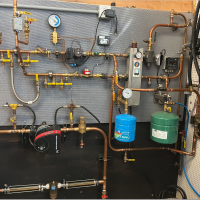Welcome! Here are the website rules, as well as some tips for using this forum.
Need to contact us? Visit https://heatinghelp.com/contact-us/.
Click here to Find a Contractor in your area.
If our community has helped you, please consider making a contribution to support this website. Thanks!
Best Of
Re: Threading pipe for slope
The correct answer for this is what the old timers called "cutting a drip thread" No one I know does this anymore. Your going to have to make it up with 90s, 45s and swing joints etc They used to cut a crooked thread on a pipe to get the slope or pitch they wanted
I've been doing this 42 years and never cut a drip thread (don't know how) I've only read about it. You would need a threader like a Ridgid 65R where you can set the gide collar on the back "off center". They also make a 65R -TC which you cannot use for this. the tc stands for "true center"
I've been doing this 42 years and never cut a drip thread (don't know how) I've only read about it. You would need a threader like a Ridgid 65R where you can set the gide collar on the back "off center". They also make a 65R -TC which you cannot use for this. the tc stands for "true center"
Re: Converting 2 pipe hot water to 3 zones?
Just in case any of that didn't make sense, we can help you figure the sizes out. http://www.slantfin.com/homeowners-page/ipadapp.html will get you started.
 SWEI
SWEI
5
Re: Converting 2 pipe hot water to 3 zones?
Pipe sizing depends on flow rate, which in turn depends on the room-by-room heat loss and an emitter survey.
How much heat does this room need on the coldest day of the year? What temperature water is needed with the radiation I have installed in order to deliver the required heat?
How much heat does this room need on the coldest day of the year? What temperature water is needed with the radiation I have installed in order to deliver the required heat?
 SWEI
SWEI
5
Re: How to bleed just 1 zone
You could shut off power. Shut the isolation flanges on that pump. Loosen the 4 bolts and rotate the pump. Then you would need to take out the 4 Allen bolts on the motor and rotate it so the electrical box faces up. You may or may not have to disconnect power wiring to the pump.
5
Re: How to bleed just 1 zone
Turn off power also. No need to dead head those other pumps if you get a heat call.On the Tstat 's they are probably setup for hot air. You will need to get into the installer setup to verify.
5
Re: Why does a 17000 btu electric boiler have 1 1/4 inch taps?
sometimes that one block gets used for a range of outputs. Just add additional, or higher KW elements. Cast iron boilers also, even a low BTU boiler might have the same tappings as larger sizes.
 hot_rod
hot_rod
5
Re: Buffer Tank - Pros and Cons?
Actually large buffers can be charged under no or low load conditions, then flywheel for weeks or months. I've seen some large solar thermal system in Europe that charge enough buffer in the summer to run the building all winter, heat and DHW with no back up and very low winter solar input.
Actually isn't hat have ground source GEO works, storing solar energy in the earth.
For hydronics it usually involves well insulated, multi thousand gallon tanks. Not for the weak of pocketbook.
Actually isn't hat have ground source GEO works, storing solar energy in the earth.
For hydronics it usually involves well insulated, multi thousand gallon tanks. Not for the weak of pocketbook.
 hot_rod
hot_rod
5
Re: Leak in return pipe.
You can always find the clamp type pipe repair kit, with a rubber gasket, which will close up a leak. In both cases, the pipe surface around the repair must be cleaned/sanded thoroughly. If the JB weld does not work, then all traces of the epoxy must be removed to make the clamp type repair work, and that can be difficult.--NBC
Re: Leak in return pipe.
Is this a wet return (down near the floor) or a dry return (an extension of your Steam Main, after the last Radiator)? How big of a leak is it? If small, you can try to clean it really well and apply some JB Weld and see if it holds until the weather breaks. If it's in the middle of a section of pipe, It obviously should be replaced as soon as the weather allows. If it is at a joint, depending on how bad it is, JB Weld may hold, if at a Flange joint, there re gaskets sandwiched inbetween the flanges that need to be replaced.
5
